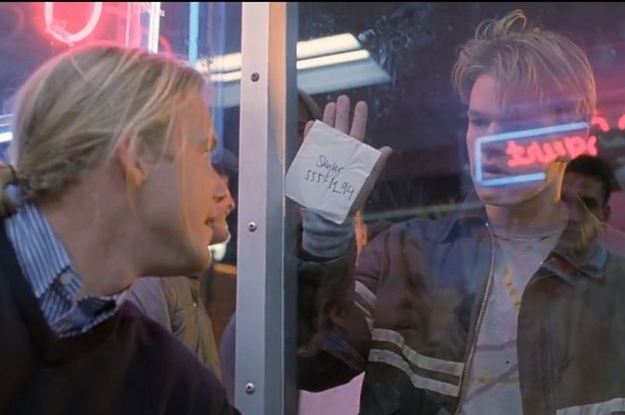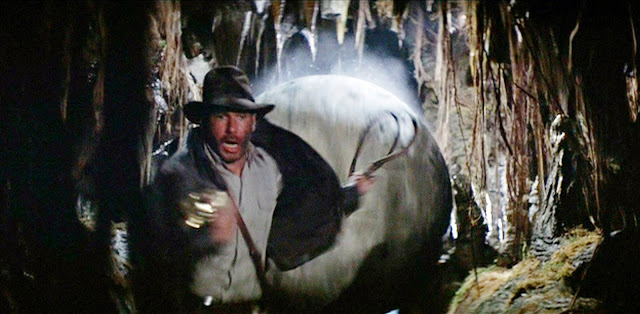
While watching the press tour for this weekend’s A Silent Place, I noticed that one of the scenes they’re highlighting is (spoiler) when Emily Blunt’s character is forced to have a baby in dead silence. It’s that movie’s “That Scene,” the scene that everybody will be talking about after the movie. The concept of having a “That Scene” is more important than screenwriters realize. One great scene can be the difference between people talking about your movie afterwards or not. And if they’re not talking about it, they aren’t encouraging anybody else to see it. I’m not saying you can have a terrible script with one great scene and you’re saved. But I will say that an average script with a great scene in it could tip the scales and get you a sale. That’s because when a producer reads one great scene and imagines how awesome that scene would be in a theater? They’re willing to work on the rest of the script’s problems JUST SO they can get that scene in a movie.
The late Blake Snyder famously chronicled how That Scene got him the biggest break of his life – selling a script that nabbed the biggest movie star in the world at the time, Sylvester Stallone. The script, “Stop Or My Mom Will Shoot,” is about a tough cop who’s frail mother comes to stay with him. Snyder tells the story of how the producer thought the script was okay. But when he read the scene where the mom is at the wheel during a car chase and won’t go over 20 miles per hour, he knew he had a movie. It was Stop Or My Mom Will Shoot’s That Scene.
Now when I talk about That Scene, I don’t mean your big payoff scene. The big payoff scene is the scene where everything that’s been set up beforehand climaxes in one giant super-scene. A good example of this is the “It’s not your fault” scene in Good Will Hunting. In that movie, Will Hunting’s inner battle is built around repressing the memories of his abusive father. That’s what Sean (Robin Williams) is trying to get to the heart of in their therapy sessions. When Sean tells Will that his dad abusing him isn’t his fault, Will finally breaks down. “It’s not your fault,” Sean keeps repeating, with Will finally letting it all out. “It’s not your fault.” It’s a great scene, but it’s not That Scene. That Scene in Good Will Hunting is the showdown with the preppy Harvard prick at the bar which culminates in, “How do ya like them apples?”
So how do write one of these scenes? I’ve been thinking about this a lot. “A Quiet Place” is a good place to start, since it has the clearest path towards finding its That Scene. So the first thing you want to do is you want to ask, “What can I do with my concept that NO OTHER MOVIE CAN DO?” The reason you want to ask this question is because you’ll be more likely to find an original scene. A Quiet Place has such a specific concept (if the family makes a noise, the monsters can locate and kill them) that finding an original scene to take place inside that concept isn’t as difficult as if you were writing, say, The Post.
The other question you want to ask when trying to write a great scene is, “What’s the worst thing I can do to my character here?” If you can combine those two things in a clever way, you can come with a That Scene. So with A Quiet Place, you’d ask, what’s the worst thing I can do to a character in a situation where they can’t make a sound? And the answer to that question would be… duh duh duhhhh, force them to give birth! Of course, that idea is great in hindsight but probably tougher to come up with in the writing stage. What if, for example, in an early draft, the mother wasn’t pregnant? It’d be hard to think of having a baby. You’d need to come up with the pregnancy idea first before that idea came to you. This is why writing is hard. Sometimes the answers are two ideas away instead of one. And you can’t always see two steps ahead.

But then we move over to “How Do You Like Them Apples” and the same rules don’t quite apply. With that said, the first rule is still in play. What’s a scene that we could ONLY write into this movie? We’ve got a tough-as-nails genius janitor. What if he had a run-in with a bully Harvard student at a bar? A student who tries to display how much smarter he is than this townie, but the townie schools him? That fits the bill as a scene that’s specific to this concept. So it works! It also shows us that we don’t always have to apply the “what’s the worst thing I can do to my character” rule to still get “That Scene.”
Another way to create That Scene is by setting it up. But a “That Scene” needs a bit more firepower, so one setup won’t do it. You’ll need multiple setups and a payoff that’s humongous! The best recent example of this occurs in Spider-Man: Homecoming, when Peter Parker shows up to pick up his prom date, only to find out that her father is… the Vulture. You can see that this also applies the “What’s the worst thing I can do to my hero” rule. What’s the worst thing you can do to someone picking up their first love? Make their father your super-hero nemesis! It’s also pretty specific to the concept. You can only do something like this in a super-hero film.
Sicario is another reminder, however, that simply asking what you can do with your concept that nobody else can do can lead to a That Scene. The scene that still stands out to me when I read that script was the border shootout. Think about it. You’re writing a movie about Mexican drug cartels bleeding over the border into the U.S. In retrospect, it seems obvious that you’d want a scene to occur right at the border. Screenwriter Sheridan then asks, “What’s the worst thing I can do to these characters?” Have them get stuck in that border traffic buildup, and surround them on all sides with Cartel members who want to kill them. I’d never read a scene like that before.

Maybe the best version of giving us a scene that ONLY that concept could provide was the opening scene in Raiders of the Lost Ark. We see our archeologist hero do what he does best – secure treasure in a booby-trapped cave. What’s cool about this scene is that it’s one continuous series of “What’s the worst thing I can do to my hero?” moments. Every step of the way, something is trying to stop him from succeeding. Which is what makes the scene so exciting. The totality of Indy overcoming all these obstacles secures it in the That Scene pantheon.
To finish off, let’s look at the biggest That Scene of them all: the shower scene in Psycho. Here’s why I – at least partly – think that this scene is still talked about 60 years later. It takes the “What’s the worst thing I can do to my hero” rule further than it’s ever been taken before. They literally KILL the hero. The shock of that, combined with how brutal the murder itself is, is what made the shower scene a THAT SCENE.
So, to summarize, to find That Scene, you want to use one or both of these rules. 1) Give us a scene that could only happen inside your specific concept. 2) Ask, “What’s the worst thing I could do to my character at this moment?” Finally, you have to be creative. Sometimes the answer is right in front of you. But other times it’s two ideas ahead, like in A Quiet Place. So play around with some ideas, write a scene a few different ways, to find that magical moment that creates That Scene. Oh, and there’s no reason why you can’t have multiple That Scenes in your script. My favorite movie from last year, Good Time, has half-a-dozen That Scenes. But let’s start with one. Whatever script you’re working on now, spend a day trying to come up with a That Scene for it. Good luck!
Feel free to share your favorite That Scenes in the comments, along with why you think they became so iconic.

